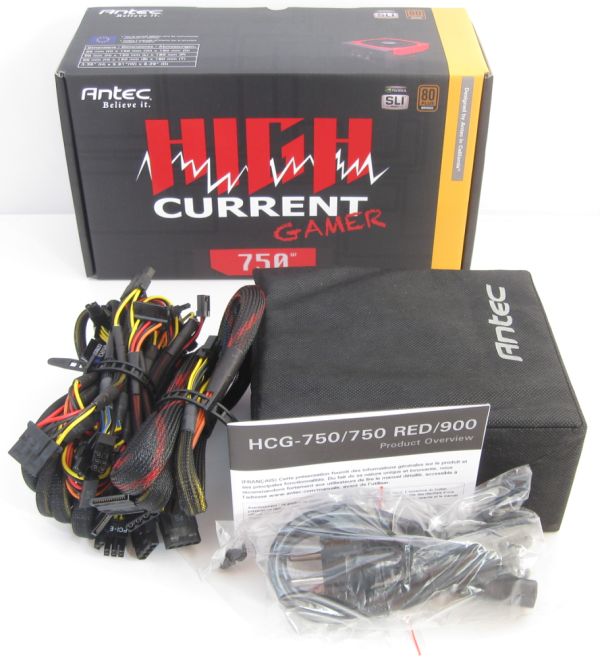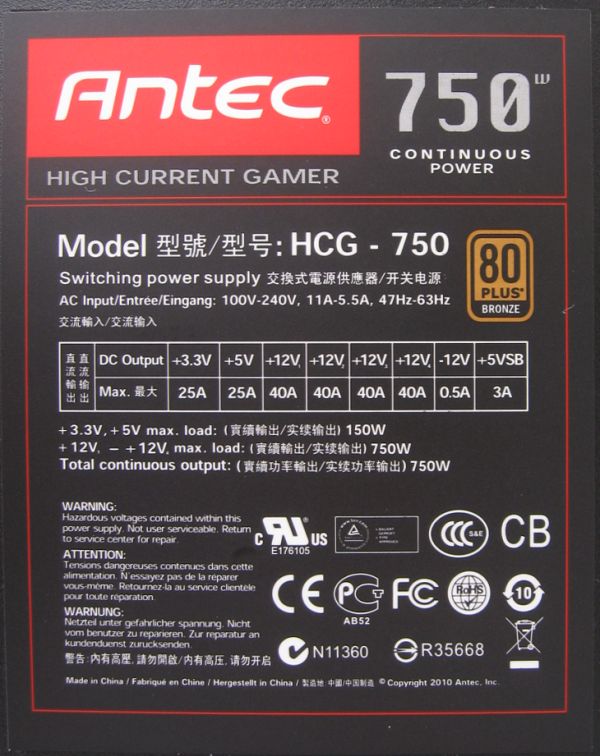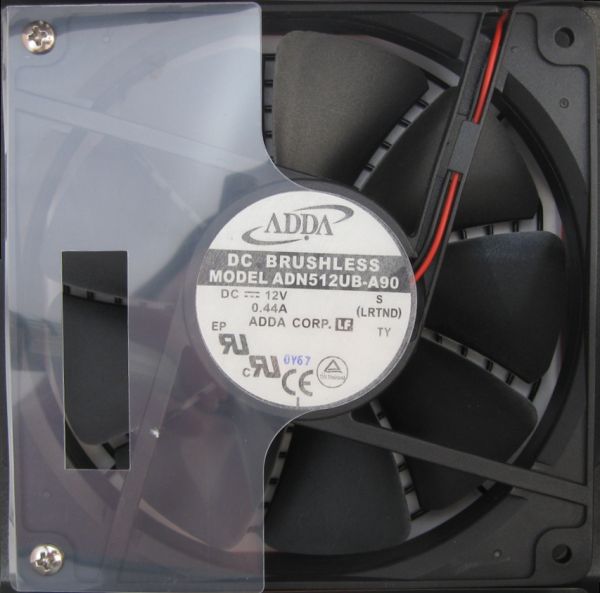Antec HCG 750W: Built for Gamers?
by Martin Kaffei on April 12, 2011 8:20 PM ESTPackage, Power Rating, and Fan
Like most PSUs, the package includes a power cord, four screws, and a small user manual. The PSU also comes with a separate cover to protect it from dust and scratches. Besides the 80 Plus Bronze and SLI-Ready logo, the HCG has 40A +12V rails, active PFC, all important safety functions, and a 5-year warranty. The High Current Gamer name is obviously in reference to the four 12V rails, which allow gamers to use the various cables without worrying about how much power they're drawing from any single rail. The housing is 180mm long, so you'll need enough space for it, and all cables are fixed.
If we trust those indications the load for one +12V rail could be up to 40A. The +12V rails are able to deliver the full output power in a peak situation while the continuous power is 750W. A specified temperature for the various ratings would have been nice, but we will verify the manufacturer information at room temperature. +3.3V and +5V are rated at 150W and/or 25A each. That's more than enough for a lot of HDD or SDD drives.
There's a large fan, but interestingly it's also covered by a large foil. We are not sure if this will help with airflow, but presumably Antec tested with and without the foil in place. The ADDA fan has the aforementioned ball bearings, with the exact model being ADN512UB-A90. This 135mm fan has nine blades and runs off 0.44A. It is not PWM controlled, unlike in most other Antec PSUs. The rated airflow of 82CFM should be enough to keep the interior cool.



















43 Comments
View All Comments
GreenLego - Tuesday, May 31, 2011 - link
Why would Nike (the sporting goods maker) make a PSU? Nike makes unobtainiums (it's their trademark isn't it?). My sunglasses are made from unobtainium.AssBall - Wednesday, April 13, 2011 - link
Not everyone thinks paying more for a sticker is worth it. I don't care what "color" it is as long as it is reliable.HEhatesusall - Wednesday, April 13, 2011 - link
PSU efficiency is the DC power output of the PSU over the AC consumption. It is NOT,i repeat, it is NOT a way to measure how "good" a PSU is,it's just a gimmick . The less AC power draw over the year can translate in...$1-$2 difference per year in electric power bills.There are sooooo many more tests to prove a PSU's efficiency(mainly ripple tests, stress tests to find the absolute maximum wattage, and capacitor aging simulations to measure the degeneration of the PSU over the years) but you seem to be stuck on a "certification". When an engineering team designs those things, there are tradeoffs between efficiency,ripple,cost of materials etc etc. As an engineer, the one i would dump to, say, 75-80% is the efficiency(for gamers,companies need high efficiency and high reliability). Games DO care MORE if i can reduce ripple by 10mV in +12V rail even if they pay $5 a year more in current, just because less ripple means extended lifecircles for all your digital parts
heymrdj - Wednesday, April 13, 2011 - link
+1 for the truth. I will pay 10$ more a year for electricity to bring down the ripple 10mv.mindless1 - Saturday, July 2, 2011 - link
Except, it isn't true. 10mV ripple has no effect whatsoever on parts lifespan, providing the peak voltages don't exceed the max the parts can tolerate and certainly it will not, any part nominally rated for an input voltage can easily tolerate far more than a few dozen mV ripple.Further and most people don't seem to understand this, the parts you are POWERING cause far more noise on the power rails than this.
There are many reasons a part can die prematurely or earlier than it otherwise would, but 10mV ripple difference isn't one of them.
Patrick Wolf - Wednesday, April 13, 2011 - link
While that is true, higher efficiency units must use higher quality parts to achieve that rating which is generally why the better the rating the better the PSU is. Of course not all PSU's are created equal, as it's always been. For gamers, the best thing about higher efficiency units is they tend to give off less heat, which is especially nice when it's mounted at the bottom of a case.7Enigma - Thursday, April 14, 2011 - link
Exactly. I don't care about the additional $1-2 for the year, I care about the removal of that as heat with my A/C in the summer, the increased case temps, the potential sound dB increase, etc.mindless1 - Saturday, July 2, 2011 - link
It is irrelevant if it is mounted at the top or bottom of the case, well actually you can tolerate a hotter running PSU at the bottom of the case because the air it intakes is less pre-heated by the CPU and other parts upstream of the chassis airflow.Heat does not rise from a PSU into the case, there is positive flow intake of air and exhaust out the back of the PSU and case, unless it is a passively cooled design (no fan in it) in which case you'd still have roughly the same rate of heated air sucked into the rest of the system if all else were equal.
I'm not arguing against higher efficiency PSU though, if the cost increase is not too great and the other properties of the PSU do not suffer as a result it is a good thing, BUT it all costs money. If you have a total design budget and spend, lets's say 20% more to get the design to a higher efficiency level with a significant design decision, that 20% could have gone to a larger transformer, better quality capacitors, etc.
It's not necessarily parts "quality" that makes a PSU more efficient, it's the design topology, # of parts, component rating vs size.
For example, I could use a very high quality choke, resistor, capacitor, and have lower efficiency than a more elaborate circuit would, or a circuit at a different operating temperature would, there is a balance between several decisions but in the end there are not many things that universally effect people except that it meets it's specs so you can choose scientifically what to mate with a known system load, and doesn't have premature fan or capacitor failure, and some resistance to surge damage on the switching transistors.
The average person, they just want it to "work", esthetics aside they aren't very picky about whether their system uses 180W versus 150W, it certainly isn't something you see the average Dell, HP, etc shopper demanding on the line item details of a system prior to purchase.
Terris - Wednesday, April 13, 2011 - link
So you would pick say a RAIDMAX Gold PSU but not this Antec because the RAIDMAX is Gold certified.Just because they slap a 80 Plus cert on the PSU doesn't mean it's built any better. I always buy components by manufacturer warranty. Corsair PSU with a 7 year warranty, yes please. Bonus for lifetime warranty manufacturers.
But hey, keep spending money on frivolous stickers if it makes you feel all good inside.
ckryan - Tuesday, April 12, 2011 - link
I think the price is a little on the high side. It should subside a little over time, but I know I am certainly willing to pay a little more for Antec and Seasonic units, my two favorites. So while it may seem a little high price wise, I believe many prospective buyers will think it a fair deal. As far as efficiency goes, it's on the high side of bronze, but I'd rather have a PSU on the high side of it's rating than the low. I think this is the other side of the EarthWatts coin, a line of fantastic PSU for the price. Plus, I'd imagine that like the EarthWatts it will be found frequently on sale.